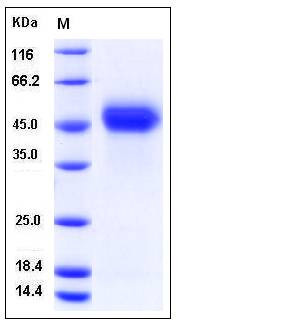Human uPAR / CD87 Protein (His Tag)
CD87,U-PAR,UPAR,URKR
- 100ug (NPP4177) Please inquiry
| Catalog Number | P10925-H08H |
|---|---|
| Organism Species | Human |
| Host | Human Cells |
| Synonyms | CD87,U-PAR,UPAR,URKR |
| Molecular Weight | The secreted recombinant human UPAR consists of 292 amino acids with the predicted molecular mass of 32.8 kDa. As a result of glycosylation, rhUPAR migrates as an approximately 48 kDa band in SDS-PAGE under reducing conditions. |
| predicted N | Leu 23 |
| SDS-PAGE |  |
| Purity | > 98 % as determined by SDS-PAGE |
| Protein Construction | A DNA sequence encoding the human UPAR isoform 1 (Q03405-1) (Met 1-Arg 303) without the pro peptide was expressed, with a carboxy-terminal polyhistidine tag. |
| Bio-activity | Measured by its binding ability in a functional ELISA . Immobilized human uPAR at 5 μg/ml (100 μl/well) can bind biotinylated human UPA with a linear ranger of 40-1000 ng/ml. |
| Research Area | Immunology |Innate Immunity |Coagulation |
| Formulation | Lyophilized from sterile PBS, pH 7.4 1. Normally 5 % - 8 % trehalose, mannitol and 0.01% Tween80 are added as protectants before lyophilization. Specific concentrations are included in the hardcopy of COA. |
| Background | Urokinase plasminogen activator (uPA) and/or its receptor (uPAR) are essential for metastasis, and overexpression of these molecules is strongly correlated with poor prognosis in a variety of malignant tumours. uPAR and uPA levels in both resected tumor tissue and plasma are of independent prognostic significance for patient survival in several types of human cancer. This system has classically been thought to drive tumor progression by mediating directed extracellular proteolysis on the surface of migrating or invading cells, and intervening with this proteolysis by targeting uPAR has been proposed to represent a novel approach for inhibiting tumor progression. uPAR, also known as PLAUR or CD87, has been implicated in the growth, metastasis, and angiogenesis of several solid and hemotologic malignancies. uPAR is a highly glycosylated, 55-60kDa integral membrane protein linked to the plasma membrane by a glycosylphosphatidylinositol (GPI) anchor. It is part of a cell surface system that also consists of the serine protease uPA and several specific inhibitors (plasminogen activator inhibitors 1 and 2). Additionally, the analysis of CD87 (urokinase-type plasminogen activator receptor - uPAR) expression has a potential role in the diagnostic or prognostic work-up of several hematological malignancies, particularly acute leukemia and multiple myeloma. |
| Reference |
